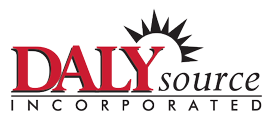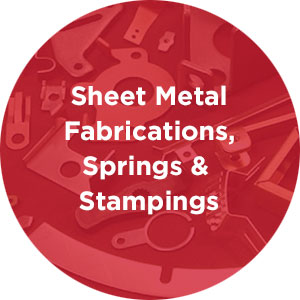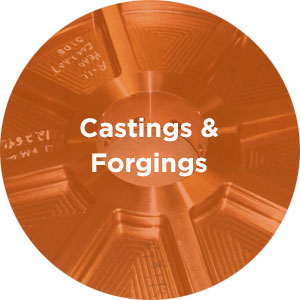SHEET METAL FABRICATIONS, SPRINGS & STAMPINGS
Laser Cutting / Waterjet
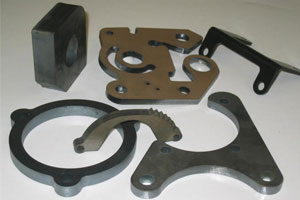
Laser cutting is a technology that utilizes a laser beam to cut materials, and is typically used for industrial manufacturing applications. Laser cutting works by directing the output of a high-power laser onto the material to be cut. The material then either melts, burns, vaporizes away, or is blown away by a jet stream of gas, leaving the edge of the part with a high-quality surface finish. Industrial laser cutters are used to cut flat-sheet material, as well as structural and piping materials.
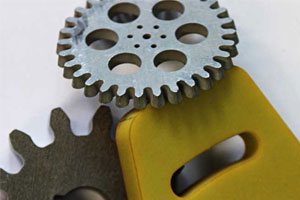
A waterjet cutter is an industrial tool capable of cutting a wide variety of materials using a very high-pressure jet of water, or a mixture of water and an abrasive substance. Waterjet cutting is the preferred method when the materials being cut are sensitive to high temperatures generated by other forming methods. Waterjet cutting is used in various industries, such as mining and aerospace.
Metal Spinning / Deep Drawing

Metal spinning, also known as spinning or metal turning most commonly, is a metalworking process by which a disc or tube of metal is rotated at high speed and formed into an axially symmetric part. Spinning can be performed by hand or by a CNC lathe.
Our spinning manufacturer can spin metal up to 80”, with material thickness between .015”-.250” and specializes in low-to-medium quantities. This manufacturer also has the capability to make custom deep drawn components up to 12” depths in unlimited volumes.
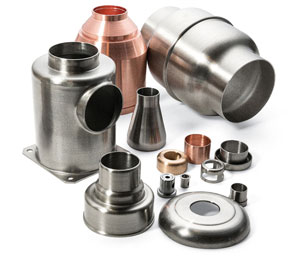
Deep drawing is a sheet metal forming process in which a flat sheet of metal is radially drawn into a forming die by the mechanical action of a punch. The process is considered “deep” drawing when the depth of the drawn part exceeds its diameter.
Photo Etching / Chemical Milling

Photo / Chemical etching is a process best suited for thin sheet metal components less than .030” thick, that can’t be stamped or fabricated on a press brake.
Sheet Metal Fabrications
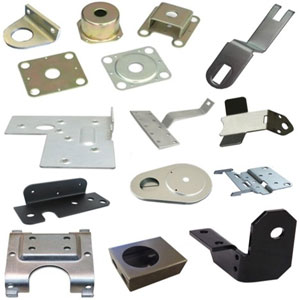
This process is ideal for short to medium production runs with volumes ranging from 1 to 250 pieces, where the sheet metal part utilizes CNC turret presses and/or CNC press brakes, and typically has a low tooling cost.
Springs & Wire Forms
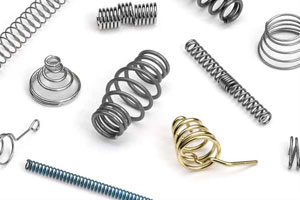
Compression Springs
used to resist a compressive force.
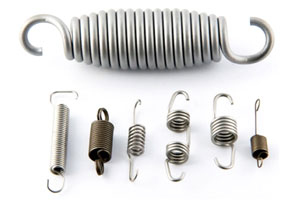
Extension Springs
used to store energy and exert a pulling force.
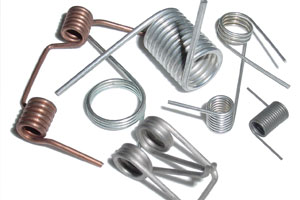
Torsion Springs
used to apply torque or rotational energy.
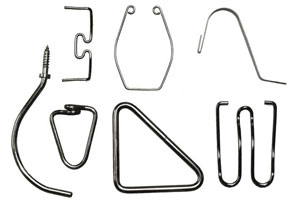
Wire Forms
wire designs can vary in material width, thickness, strength, form and function.

Flat Metal Springs
flat metal designs can vary in material width, thickness, strength, form and function.
Short-Run Stampings
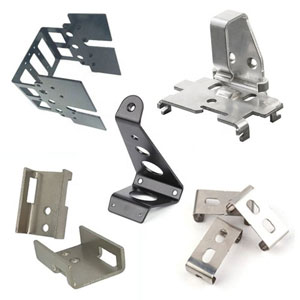
A process suitable for sheet metal parts in volumes ranging from 100 to 25,000 pieces, where the part needs to be blanked, pierced, formed, drawn or extruded, utilizing punch presses ranging from 18 tons to 215 tons, usually with a minimum one-time tooling cost.
Tube Bending & Wire Fabrication

The tube bending process is used for components in various industries and any tubing material, up to 2″ diameter. There is an inventory of mandrels, so there is a low tooling cost.
Tube bending is done for tubes with round, rectangle, and square cross sections to the specified tolerances. Hydraulic tube benders produce tubular components that comply with stringent Mil-Spec standards. End-finishing machines create flair, swage, reduce, and expand tube components. Special assembly operations such as bending, assembling, and brazing are also offered.
Prototype Sheet Metal Parts:
Prototype or pre-production sheet metal parts can be made utilizing the stamping, fabricating, springs and wire forms processes.
